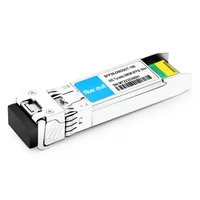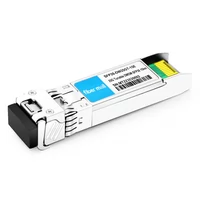The 25G Tunable DWDM SFP28 transceiver is designed to meet the high-bandwidth needs of modern optical networks. This product has many advanced features and specs. These include a data transfer rate that can reach 25 Gbps and is fit for data centers, telecommunications, and enterprise networks. It does support ITU-T G.694.1 compliant DWDM channels, which allow dynamic wavelength tuning over a wide range of channels, hence utilizing the available spectrum more effectively.
Among its specifications are hot-pluggable SFP28 footprint for easy use and compatibility with existing hardware; high transmission distance up to 40 km enabled by efficient external cavity laser and advanced forward error correction (FEC) technology that ensures data integrity while minimizing packet loss.
Additionally, this device is built with an extended operating temperature range to work reliably in different environmental conditions. Not only does this 25G Tunable DWDM SFP28 offer flexibility in deployment, but it also consumes less power, which makes networks more efficient and saves on operations costs, thus making it suitable for scalable and future-proof network infrastructures.
Table of Contents
ToggleWhat is a 25G DWDM Tunable SFP28 Transceiver, and How Does It Work?
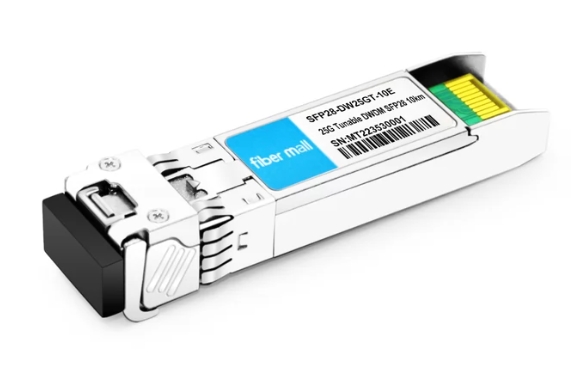
Understanding the Basics of DWDM
Dense wavelength division multiplexing (DWDM) is a technology that simultaneously transmits multiple signals using different wavelengths of light over optical fiber networks to increase their capacity. Each channel, or wavelength, can accommodate a separate data stream, hence making use of the fiber optic infrastructure more effective. The term “25G” in 25G DWDM Tunable SFP28 Transceiver stands for 25 gigabits per second, the rate at which information is transferred. By changing frequencies within the DWDM spectrum dynamically for each channel, tunable transceivers optimize available bandwidth while simplifying network management; this, in turn, improves scalability and efficiency in data centers as well as telecommunication or enterprise networks.
What Does “Tunable” Mean for SFP28 Transceivers?
Within the DWDM range, “tuneable” in SFP28 transceivers refers to that feature of a transceiver which enables it to modify its operating wavelength on-demand. A single predefined wavelength is used by fixed-wavelength transceivers, unlike tuneable ones, which can work at any specified range of wavelengths; this flexibility permits optimization of available frequencies by network operators and simplification in inventory management because only one tuneable transceiver is needed instead of many fixed-wavelength units.
Here are some critical technical parameters for such a device:
- Wavelength Range: Normally covering the C band from 1530 nm up to 1565 nm so that multiple data transmission channels can be provided.
- Data Rate: It supports up-to 25 Gbps that ensures high-speeds data transfer rates.
- Output Power: Usually between -1 dBm and +3 dBm, depending upon different models and application requirements.
- Receiver Sensitivity: Typically about -14 dBm, guaranteeing reliable reception of information.
- Tuning Granularity: It usually varies, with each channel spaced at 50 GHz or 100 GHz, allowing an accurate selection of wavelengths.
- Power Consumption: Around 3.5W is designed for energy saving but still maintaining high-performance levels.
- Operating Temperature Range: Often from 0°C to 70°C to cater to wide-ranging environmental conditions.
These parameters are necessary because networks need flexibility, efficiency, and high performance in different situations. Therefore, tunability should provide all these features. This makes them suitable for modern optical networks, where versatility and scalability are required to meet various demands.
Technical Specifications of 25G DWDM SFP28
The 25G DWDM SFP28 is perfect for data centers and telecoms of the future. It has the following main features:
- Wavelength Range: The range spans from 1529.16 nm to 1567.95 nm, which belongs to the C-band in DWDM, making it possible to use up to 96 channels.
- Data Rate: It supports 25 Gbps hence can work with any high-speed network today.
- Transmission Distance: Depending on different models and network requirements, this can vary between 40 km and 80 km.
- Modulation Format: Depending on the need, NRZ (Non-Return-to-Zero) or PAM4 (4-level Pulse Amplitude Modulation) may be used as the modulation format.
- Output Power: Typically -1 dBm to +2 dBm so signals can travel long distances without losing strength.
- Receiver Sensitivity: Around -16 dBm receiver sensitivity enables robust performance under various conditions, ensuring reliable data reception even when things are not going well outside.
- Tuning Granularity: Either 50 GHz or 100 GHz channel spacing provides a fine level of control over wavelength selection while still allowing flexibility where it is most required.
- Power Consumption: Designed for optimal trade-off between energy efficiency and performance such that it consumes about 3.5W only
- Operating Temperature Range: It operates within an environmental temperature range of 0°C to 70°C thus can be used anywhere regardless of the climate difference
Compatibility: Conforms fully with IEEE802.3 standard together with MSA specifications so that it can work alongside other existing network equipment
Why Choose a Tunable DWDM SFP28 for Your Network?
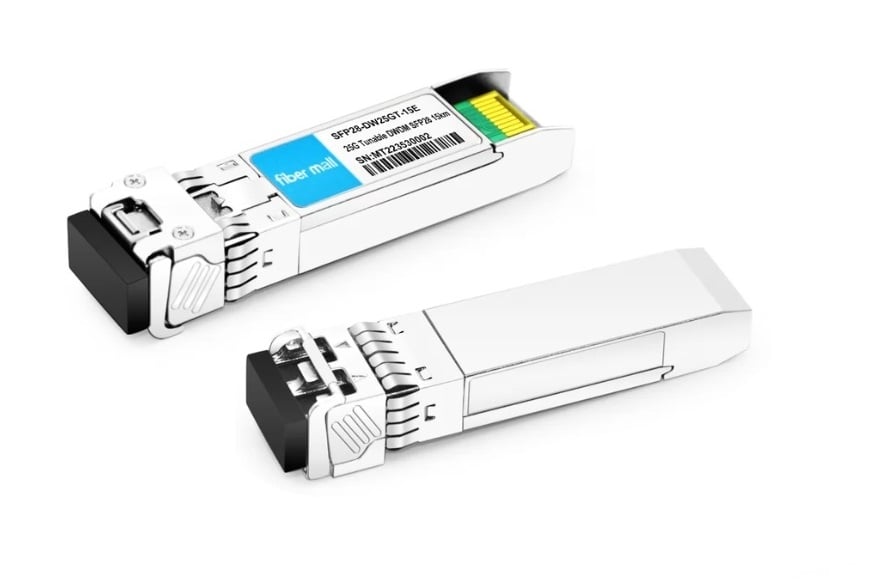
Advantages of Tunable over Fixed Wavelength SFP28
Compared to their fixed-wavelength counterparts, tunable DWDM (Dense Wavelength Division Multiplexing) SFP28 transceivers offer many benefits. First, they open up flexibility because the wavelength can be adjusted dynamically; this makes inventory management easier and saves on multiple stocks of fixed-wavelength transceivers. Operations costs are reduced while network agility increases because the same transceiver may be used across different channels as network demand varies over time.
Secondly, these devices help with scalability and maintenance simplicity in networks. Network operators can change wavelengths without having to replace the whole transceiver physically, reducing downtime and cutting down on what would have been spent on maintenance. Such a feature becomes crucial for dynamic or rapidly changing network environments where quick fixes must be made to keep everything at its best.
In addition, they also contribute towards efficient utilization of existing infrastructure, which implies that they optimize wavelength allocation, thereby making better use of available spectrum and maximizing optical network capacity usage. Therefore, being versatile like this makes them suitable for current and future-proofing network infrastructures since they can adapt according to different needs over time.
Applications for 25G DWDM in Modern Networks
To satisfy the wants of contemporary systems, it is essential to have 25G DWDM technology that enables high capacity and low delay connections required for different uses. One main area where this technology is used is data center interconnects; here, it allows effective and scalable connectivity between data centers, thereby supporting massive amounts of cloud computing or big data analytics traffic. Additionally, 25G DWDM serves as a critical enabler for metro networks; these offer cost-efficient solutions in densely populated cities where millions need to be connected through high-volume communication links as they generate more information.
Another significant importance of 25G DWDM lies within 5G mobile backhaul networks; global deployment implies robustness, and flexibility is necessary for any backhauling solution adopted at such a scale. It offers enough flexibility and the bandwidth required by ultra-low latency services demanded by these high-speed fifth-generation cellular systems, thus ensuring uninterrupted service provision and enhanced user experience. Moreover, even enterprise network utilization includes financial institutions’ use cases, among others, since large organizations may have critical applications depending on secure channels with huge capacities, which can only be achieved using this type of technology.
Compatibility with Existing Network Infrastructure
The 25G DWDM technology should work well with present-day network architecture to ease transition and integration procedures. This means it can operate with old-fashioned systems, permitting network operators to upgrade the bandwidth capacity without necessarily overhauling their current infrastructures entirely. Such like-mindedness is achieved through conformance to industry norms as well as adaptability for use with aged optical devices such as 10G, 100G among others. Another way in which this can be done is by plugging SFP28 or any other interchangeable optic module into any already existing hardware component, thereby making its deployment more convenient and cheaper. To ensure future relevance vis-à-vis growing demands on networks while at the same time protecting previous infrastructure investments made; twenty-five gigabits per second dense wave division multiplexing has to remain compatible with legacy networks.
How to Install and Configure a 25G Tunable DWDM SFP28 Module?
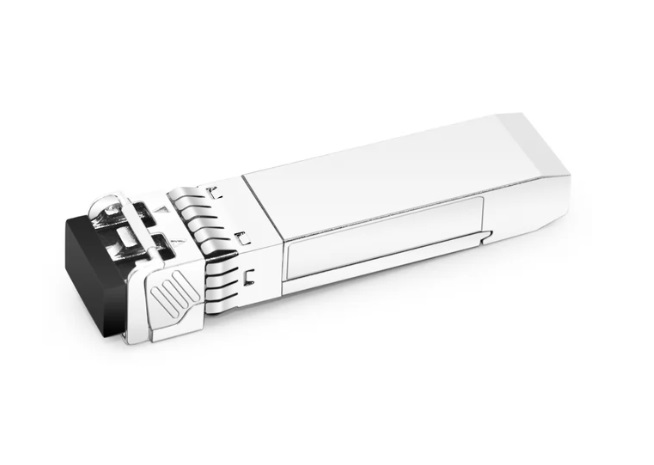
Step-by-Step Installation Guide
- Test for Compatibility: Verify that your network equipment and the specific DWDM channels you intend to use are compatible with the 25G Tunable DWDM SFP28 module. Check the devices’ technical datasheets.
- Turn Off Power on Equipment: Switch off power on the equipment where the SFP28 will be plugged into. This will help avert any problems that are likely caused by hot swapping.
- Clean Optical Connector: Utilize an appropriate tool for cleaning fiber optic to clean connectors. Proper cleaning prevents signal loss and preserves the optical communication’s integrity.
- Put in the SFP28 module: Carefully insert the 25G Tunable DWDM SFP28 module into the switch, router, or other compatible equipment’s SFP+ port. Ensure it is firmly clicked into position.
- Connect Fiber Patch Cable: fasten suitable fiber optic patch cable onto the SFP28 module. Make sure that connector specifications (LC/UPC or LC/APC) match those provided by modules.
- Power On Equipment: Turn network equipment on and let it detect the newly inserted SFP28 module. Look out for any status LEDs indicating a successful connection.
- Configure Module: Access the network device’s management interface (CLI or Web GUI) and set the wavelength/channel of the 25G Tunable DWDM SFP28 module according to your networking plan.
- Test Connection: Carry out diagnostic tests to ascertain whether connection was established. Verify signal quality, optical power levels and validate data transmission integrity.
- Monitor & Maintain: Continuously monitor performance of both overall network and individual SFP28 modules for optimal functionality; periodically clean optical connectors and replace suspect components as necessary.
Configuring the Wavelength Settings
To configure the wavelength settings for a 25G Tunable DWDM SFP28 module, follow specific steps through the network device’s management interface (CLI or Web GUI). These settings align with current industry best practices, as stated in authoritative sources.
- Access the Device Management Interface: Begin by connecting to the network device’s management interface. You can do this using SSH for CLI access or through a web browser for Web GUI access.
- Go to Transceiver Settings: While in the management interface, find where the transceiver or optical module settings are located. They are.
- Choose Tunable DWDM SFP28 Module: Identify and select the correct 25G tunable DWDM SFP28 module; make sure it is the right port and module so that configuration errors do not occur by accident.
- Adjust Wavelength/Channel: Set up the wavelength/channel desired for module configuration according to a certain wavelength value entry or selection from a pre-defined channel list, which often follows the ITU-T grid.
- Apply & Save Settings: After selecting the desired wavelength, apply the changes and save them into the device’s configuration file so they become permanent even after rebooting.
- Confirm Configuration: Check if the wavelength has been properly set by performing verification steps; these include checking the operational status of the current module and ensuring it transmits without any errors at the configured wavelength.
By following these steps, you will ensure that your optical network has been set up correctly, thus maximizing its performance as well as reliability. However there may be some regular monitoring plus adjustments needed based on the overall network plan.
Using Diagnostic Tools and DDM Functions
Diagnostic tools and digital diagnostic monitoring (DDM) capabilities are necessary to preserve and enhance the performance of optical transceivers. These utilities can perform real-time network monitoring by keeping track of Optical Power, Temperature, Voltage, and Bit Error Rate parameters, which are instrumental in prompt identification and diagnosis of potential problems.
- Get into Diagnostic Information: Go to the network management interface and navigate through sections until you find diagnostic tools. It may also be found under settings for transceiver optics modules.
- Monitor Important Parameters: Use DDMs for key parameter monitoring, such as transmit or receive power level, module temperature, supply voltage, and laser bias current.
- Interpret Data: Compare collected data against standard thresholds to identify any abnormality. For instance, high error rates or strange values could mean signal degradation, among other things.
- Create Reports: Create reports on diagnosis activities carried out over a period of time. This data can be used to analyze trends, especially if they were done regularly for proactive maintenance purposes.
- Calibrate/Adjust: Clean connectors tighten screws, align optics replace faulty components. With reference to these tests, one should make necessary adjustments on transceivers, i.e., alignment optimization or even connector cleaning, in case an indication shows such need.
- Ensure Conformance: All diagnostics must adhere to industry standards; hence, it is important that one verifies this after undertaking them because failure would affect the performance of the whole system (network).
The aforementioned diagnostic tools and features enable administrators to monitor their optic networks, ensuring reliability while preventing failures before they become critical.
What Are the Key Features of the 25G DWDM Tunable SFP28?
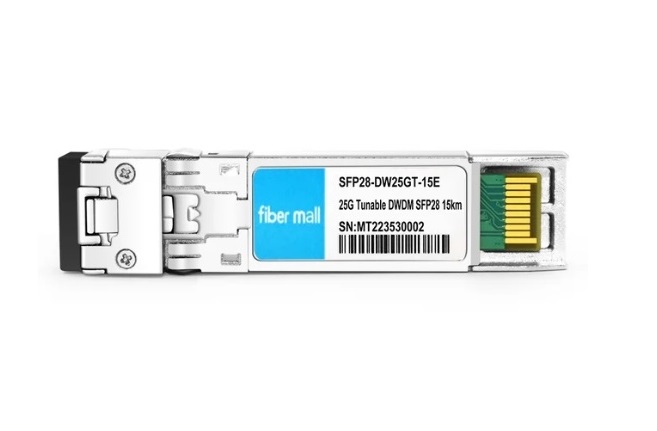
Technical Highlights: Data Rate and Distance Capabilities
This transceiver is called a 25G DWDM Tunable SFP28. This optical networking device was designed with the most up-to-date features in mind. It can support data rates of up to 25 Gbps, which meets the needs for high-speed data transmission. The technology used in this transceiver is called Dense Wavelength Division Multiplexing (DWDM), which allows it to send information over 40 km on single-mode fiber (SMF) without significant loss of quality in the signal. This long reach makes it perfect for use in metropolitan area networks (MANs) and other types of long-haul networking applications. In addition, it has tunability that enables better utilization of wavelength resources by optimizing them depending on need and improving efficiency in wavelength management, thus enhancing network performance overall.
MSA Compliance and 100GHz Channel Spacing
Following the Multi-Source Agreement (MSA) standards, the 25G DWDM Tunable SFP28 transceiver guarantees it will work well with different network equipment. In this respect, it can be installed easily into any system and used to become effective. Also, it has a channel spacing of 100GHz which is an important characteristic of DWDM technology. This means that more channels can be packed together within the optical spectrum, thus maximizing bandwidth utilization while improving overall data transmission capacity. Compliance with these measures ensures strong performance, scalability, and ease of use in different optical networking environments for 25G DWDM tunable SFP28.
Industrial Temperature Range and Reliability
To work in industrial settings, where it is typical to face different and sometimes difficult surroundings, this device has been created so as to be able of working within -40°C to +85°C range of temperatures. It is constructed with strong materials, which make it robust, thus ensuring its consistency and reducing breakdowns that may lead to a lack of network steadiness. Furthermore, this item is taken through a series of tests meant to check its ability to correspond with reliability standards set by the industry, hence proving suitable even in situations where data transmission must not be interrupted over long distances or metropolitan areas (mission-critical applications). Consistency matters most when dealing with such networks because they should always perform uniformly without fluctuations.
How to Ensure Optimal Performance of Your 25G Tunable DWDM SFP28?
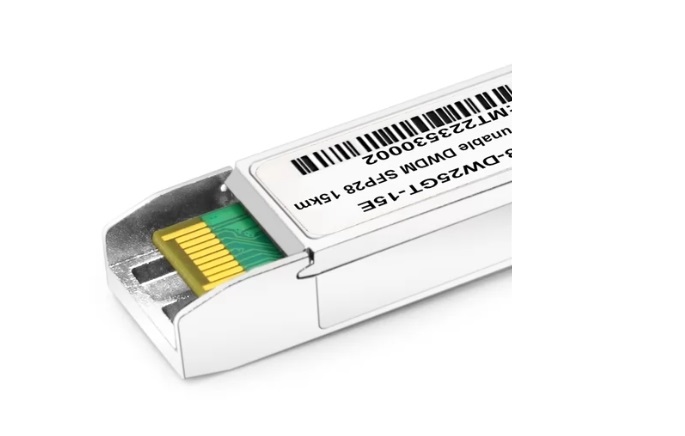
Proper Handling and Cable Management
If you want your 25G Tunable DWDM SFP28 transceiver to perform at its best, you need to know how to handle it properly and manage cables correctly. Start with the basics: always handle the transceiver by its edges; never touch any optical surfaces because they will leave fingerprints or dirt that can degrade performance. When not connected, use dust caps to cover up optical ports. Make sure you are grounded when installing or removing so as not to cause electrostatic discharge (ESD) damage.
In terms of cable management, ensure that only high-quality cables meeting the required specifications for your transceiver are used. Never bend a cable beyond the minimum bend radius, as this may damage it, resulting in errors during data transmission. Properly organize them so there is no tension or stress on connectors, which might also affect performance negatively. To make identification easier and prevent accidental disconnections, thus making maintenance tasks more manageable, label different cables with color-coded ties. Following these few steps will greatly minimize the risk of ruining your fiber optic network while maximizing its efficiency.
Monitoring and Diagnostics for Maintenance
Monitoring and diagnosis are necessary to ensure that your 25G Tunable DWDM SFP28 Transceivers are working at their best. Use real-time monitoring tools with Digital Diagnostic Monitoring (DDM) or Digital Optical Monitoring (DOM) capabilities. These tools provide essential parameters like temperature, voltage, laser bias current, and optical output/input power levels, which will help in the early detection of potential problems.
Deploy network management software that provides comprehensive monitoring solutions together with SNMP (Simple Network Management Protocol) traps integration. This makes it possible to track performance metrics continuously as well as manage faults thus leading to faster response time on any abnormality detected. Regular diagnostic checks should be done supplemented by firmware updates so that the transceivers can operate at the highest level of efficiency possible. It is important to analyze collected data frequently, looking out for trends that may indicate impending issues, thereby allowing for proactive maintenance and reducing the chances of unexpected downtimes.
Troubleshooting Common Issues
When trying to fix common problems with 25G Tunable DWDM SFP28 transceivers, there are a few things you can do:
- Link Failures: Start by checking the physical connections. Make sure that all connectors are clean and properly plugged in. An optical Time-Domain Reflectometer (OTDR) can also locate any fiber breaks or imperfections. Another thing is to inspect transceivers for physical damage or contamination.
- Signal Loss or Degradation: Look at the diagnostics for power levels. If the optical power is too low, refine fiber lossy junctions and clean connectors. Measure attenuation to ensure it falls within acceptable range. Confirm the module operates at the correct wavelength and is well-tuned.
- Intermittent Connectivity: Investigate environmental factors such as temperature changes or electromagnetic interference. Employ real-time monitoring tools that can track performance over time for any pattern shifts. Regularly update the firmware on your network management system and transceivers so they stay compatible.
Each step here offers a methodical way of dealing with these frequently encountered problems which should result in better reliability for your fiber optic network while minimizing downtime disruption.
Frequently Asked Questions (FAQs)
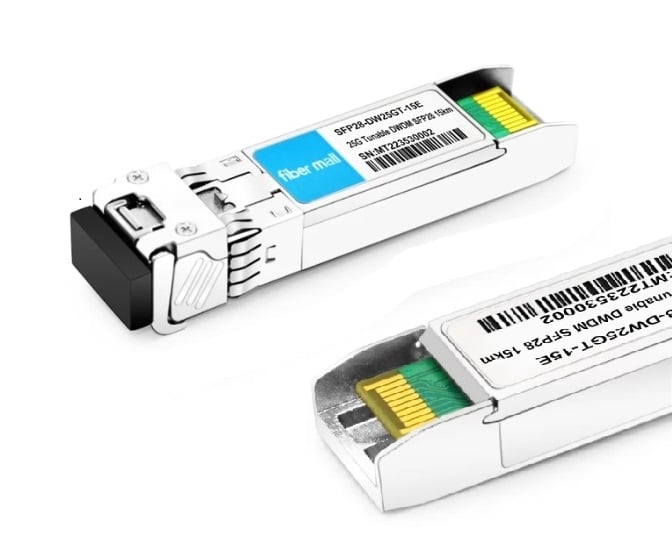
Q: What exactly is a 25G Tunable DWDM SFP28 Transceiver?
A: The 25G Tunable DWDM SFP28 Transceiver is an advanced optical transceiver module that supports 25Gbps Ethernet designed for dense wavelength division multiplexing (DWDM) technology in the C-band. It allows tunable wavelengths across multiple channels, making it flexible and high-performance for data center and telecom applications.
Q: How does it support high-density optical interconnect solutions?
A: This transceiver supports high-density optical interconnect solutions by transmitting multiple signals over a single fiber using tunable wavelengths. This maximizes the utilization of existing fiber infrastructure and boosts data centers’ capacity and network environment.
Q: What are the transmission distances achievable with this component?
A: Transmission distances of up to 15km on single-mode fiber (SMF) can be supported by the 25G Tunable DWDM SFP28 transceiver module. It is used for medium to long-range communication links in optical networks.
Q: Please tell me which compliance standards apply to it.
A: Multiple industry standards such as RoHS, ITU-T, and SFF-8472 have been complied with by the 25G Tunable DWDM SFP28. It ensures compatibility with many types of optical networking equipment while maintaining high levels of safety and environmental friendliness.
Q: Are these Transceivers compatible with existing SFP28 modules?
A: Yes, they are compatible with existing SFP28 modules. They can be easily integrated into current optical networking equipment without glitches, ensuring smooth network performance upgrades or transitions.
Q: Can it be used in OEM devices?
A: Yes it can be used in OEM devices. It has been manufactured to meet OEM specifications so as to deliver optimal performance and reliability across different branded network systems.
Q: Which kinds of connectors are used by the 25G Tunable DWDM SFP28?
A: The LC duplex connectors are most commonly used for fiber optic connections with the 25G Tunable DWDM SFP28. Their compact size and environmental protection features make them ideal for high-density networking environments.
Q: What benefit does the tunability feature of the 25G DWDM SFP28 provide to optical networks?
A: The wavelength can be adjusted across the C-band, which supports 48 channels, due to the tunability feature of the 25G DWDM SFP28. This allows for efficient wavelength management and adaptability to changing network needs, thereby eliminating multiple fixed-wavelength transceivers.
Q: In what scenarios can a 25G Tunable DWDM SFP28 Transceiver be deployed?
A: Data center interconnects (DCIs), metropolitan area networks (MANs), long-haul networks (LHNs), 5G wireless backhauls, and high-density cabling solutions represent examples where one would deploy a Twenty-five Gigabit per second (25G) Tunable Dense Wavelength Division Multiplexing (DWDM) Small Form-Factor Pluggable Double Fiber Optic Transceiver Package (SFP+) transceiver – also known as a “module”. It is specifically designed for applications that demand large amounts of data bandwidth over long distances.
Q: How does rigorous industrial product testing influence the quality of 25G Tunable DWDM SFP28 Transceivers?
A: Rigorous industrial product testing ensures quality and reliability in Twenty-five gigabits per second (25 Gbps) tune-able dense wave division multiplexing small form factors pluggable double fiber optics transceiver packages such as those marketed under brand names like TWINAX or TWINBAX. Manufacturers carry out tests such as thermal cycling, vibration, and signal integrity tests to ensure that their products meet strict performance standards and can operate reliably in harsh environments where they may be subjected to extreme conditions such as temperature fluctuations or mechanical shocks.

